Deciding on Control Measures
If your risk assessment on a site shows that the level of risk is unacceptable then you must find a way to reduce it to an acceptable level.
The accepted health and safety methodology suggests that first you should see if the hazard can be eliminated; or, should this prove impossible, you should act to prevent access to the hazard. Whilst this approach is very useful for managing risks in the workplace, it is often not appropriate for managing risk to recreation visitors. This is discussed in detail here
We show how the hierarchy could apply to managing the risk of falls from height in historic properties.
All the examples that follow are site-specific, with decisions taken on the basis of a local risk assessment.
Deciding on Control Measures
If your risk assessment on a site shows that the level of risk is unacceptable then you must find a way to reduce it to an acceptable level.
The accepted health and safety methodology suggests that first you should see if the hazard can be eliminated; or, should this prove impossible, you should act to prevent access to the hazard. Whilst this approach is very useful for managing risks in the workplace, it is often not appropriate for managing risk to recreation visitors. This is discussed in detail here
We show how the hierarchy could apply to managing the risk of falls from height in historic properties.
All the examples that follow are site-specific, with decisions taken on the basis of a local risk assessment.
[block_anchor] => [block_format] => custom_subnav [block_introduction_title] => [block_custom_subnav] => [block_section_heading] => [product] => [product_text] => ) [1] => stdClass Object ( [block_count] => 1 [layout] => text_block [slug] => block-48734e48 [title] => [source] => page [visibility] => 0 [background_colour] => bg-transparent [block_width] => full [width] => stdClass Object ( [container_class1] => container-fluid bg-transparent p-4 mb-4 [container_class2] => container [container_class3] => ) [class] => fcb-text_block [content] =>Eliminating the hazard
Raising the ground level next to the castle wall walk largely eliminates the hazard of falling from height at the furthest part and (nearer the camera) reduces the harm from a possible fall. This solution is comparatively rare, but can also be found, for example, when an old mine shaft is filled or capped.

Image Stirling Castle, Stirlingshire
Preventing access
Access to a drop can be prevented by bars or grilles. This is the most complete form of physical protection, with the risk eliminated entirely. This solution is more likely where the consequences of a fall are a certain fatality.

Image Stirling Castle, Stirlingshire
Restricting access by deterrent fencing
This is perhaps the most common physical solution, by using post and rail or steel bars. The spacing of the rails deters access but doesn’t entirely prevent it.
The type of material, its strength and the method of fixing would hold the barrier in place if a person fell against it.
There is an assumption that visitors will act reasonably and exercise personal responsibility.
The fencing in these examples will deter access effectively and will prevent inadvertent falls but will not stop a visitor determined to climb the barriers.

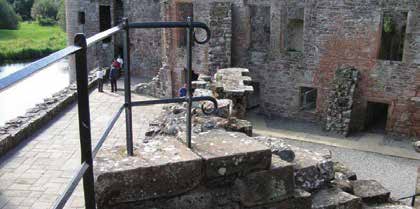
Images (L) Stirling Castle, Stirlingshire (R) Caerlaverock Castle, Dumfries & Galloway
Restricting access by edge protection
An existing parapet provides a degree of edge protection but its height may be lower than ideal. The width of the outer wall provides protection, although the embrasures are low. On the inside, barriers prevent falls from the Upper Gun Platform to the Gun Room below.
If the existing protection is retained without alteration, there will be some residual risk which needs to be justified within the risk assessment.

Image Portland Castle, Dorset
Restricting access by symbolic fencing
Here the design and choice of materials (such as a rope or single rail) suggest to the visitor that access to an area is denied; but it is easy for a visitor to evade or step over the barrier.
The type of material used and the method of fixing would not necessarily hold the barrier in place if a person fell against it. This is a common solution where the fall height is not great and the consequences relatively minor, (or the exclusion is for conservation or operational reasons).
In some cases, bushes or vegetation are used as a deterrent, although deciduous plants may not be effective in winter.


Images (L) Dirleton Castle, North Berwick, East Lothian (R) Culross Palace, Fife
Access to the drop is not restricted but a handrail or handhold is provided away from the drop
The handrail provided on the wall adjacent to steps leading down from the outer defences to Queen Anne’s Garden encourages visitors away from the edge and helps reduce the likelihood of slips and trips.

Image Stirling Castle, Stirlingshire
Providing partial edge protection
Barriers are provided for limited sections where the likelihood of a fall is greater.
The dry moat around the fort gives rise to a risk of falls. The hazard is, however, obvious and relatively easy to see. For the most part there is no edge protection.
Barriers are provided for a short length on either side of the approach to the main pedestrian access bridge.

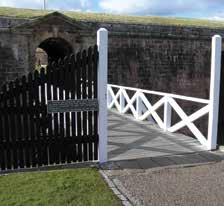
Images Fort George, Inverness
Access to the drop is not restricted but the consequences of a fall are made less severe
You could make changes to the ground level to reduce the fall height and/or soften the surface onto which a person might fall. This is a less common solution in an historic building but can be found at a play facility.
Sometimes the effect can occur naturally over time. For example, silt accumulating in a moat or ha-ha may reduce the height of a fall and the likely severity of its consequence.

Image Ardress House, Co. Armagh
Conservation or reinstatement of the historic fabric to remove a hazard or reduce its severity
Castle Rushen is one of our finest medieval castles. The original roof of the West Tower was altered during the 19th century. A steeply pitched slate roof created a hazardous unprotected drop, of over a metre, down to the level of the rainwater gutter. By 2011 repairs were needed to the leaking 19th century roof. The opportunity was taken to reinstate the original design. The flatter profile of the medieval lead roof reduces the likelihood and severity of a fall to an acceptable level.

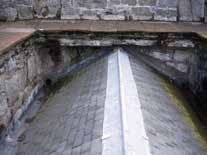
Images (L) Castle Rushen, Isle of Man (R) Castle Rushen, Isle of Man before works
Managing access
You can create routes that encourage visitors to avoid hazardous drops. These do not necessarily need to be surfaced paths.
A mown path at Lowther Castle Gardens helps to keep visitors away from the edge of the escarpment.
Mowing or strimming the vegetation can also be used to reveal a hazard. Although this at first seems contradictory, it can be seen to work in practice.
At Fountains Abbey, mowing the edge of the drop makes it clearly visible to visitors as they approach. But they are guided away from it by the obvious mown path leading them through the arch. Remember that this method of control may become less effective in the winter as the grass dies back, making the distinction less well defined.


Images (L & R) Lowther Castle, Penrith, Cumbria

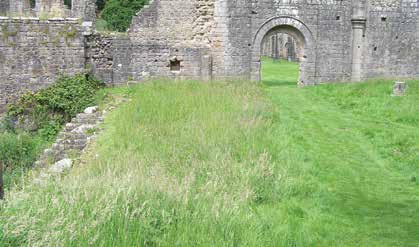
Images (L & R) Fountains Abbey, Ripon, North Yorkshire
Actively managing the hazard to make it as obvious as possible
Regular strimming of grass along the edge of a modest drop like a ha-ha may be sufficient to make it easy to avoid.
At Fort George, where the height of fall from the ramparts is more significant, signs incorporating a pictogram are also used to draw attention to the sudden drop.

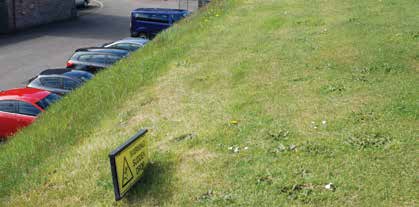
Images: (L) Chirk Castle Garden, Wrexham (R) Fort George, Inverness
Providing warnings and information on signs and leaflets
Visitors can be informed on entry to the property about hazards that they might encounter. This could be on notices or literature.
Signs might also be used within the property where the risk is about to be encountered. Sometimes they might be the only type of risk control. In other circumstances they may be used in addition to provision of physical barriers.
Warning visitors about the nature of hazards on the site allows them to decide whether or not to proceed.
Warning symbols should be used whenever possible as they avoid the need for translation.
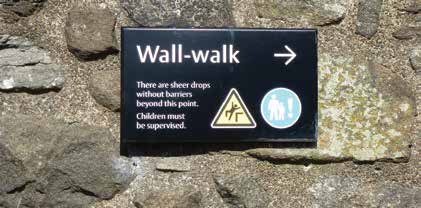
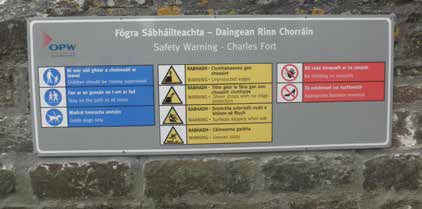
Images: (L) Stirling Castle, Stirlingshire (R) Charles Fort, Kinsale, Co. Cork
No physical intervention required
Your risk assessment may indicate that it is reasonable to accept the risk without introducing physical controls. At moderately and heavily visited sites people would usually be given advance information and warning, or the hazard would be very obvious.
This is the case at Caerlaverock Castle. Here, in addition, the visitor would have to deliberately step up onto the outer wall to be exposed to the risk. Installing a conventional barrier would have an adverse visual impact on the heritage value of the iconic remains of the south curtain wall; a rail might even encourage visitors to pull themselves up onto it. There are no known incidents of falls. A throw line is located at a central point of the wall to provide assistance should anyone fall into the water.
The three visitors in Fountains Abbey are standing on a level area, 1.3 metres wide, with low parapets on either side. In one direction there is a fall hazard of 4 metres onto the grass that now forms the floor of the refectory. On the other side there is also a fall risk down to the stone floor of the kitchen.
The hazard is very obvious and can only be reached by climbing the stone steps seen through the arch. There are no recorded falls at this point in the Abbey and the likelihood of one happening is assessed as remote.
There are numerous similar hazards at Fountains Abbey. Installing physical barriers would massively harm the heritage asset value of the site.
Visitors are warned of hazards on the information board at the entrance to the visitor centre and in the leaflets provided when they pay to go into the Abbey ruins.
In all cases, the decision to accept a residual risk should be justified and recorded. You can see an example of this in the case study for Dryburgh Abbey.


Images (L) Caerlaverock Castle, Dumfries & Galloway (R) Fountains Abbey, Ripon, North Yorkshire
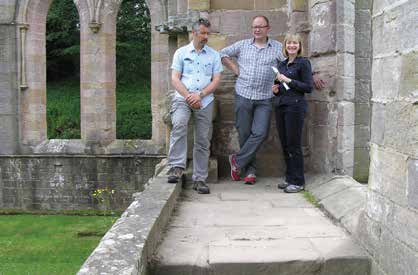
Image Fountains Abbey, Ripon, North Yorkshire
[block_anchor] => [block_format] => full_width [block_introduction_title] => [block_custom_subnav] => [block_section_heading] => [product] => [product_text] => ) [2] => stdClass Object ( [block_count] => 2 [layout] => text_block [slug] => block-c5ecc94e [title] => [source] => page [visibility] => 0 [background_colour] => bg-transparent [block_width] => full [width] => stdClass Object ( [container_class1] => container-fluid bg-transparent p-4 mb-4 [container_class2] => container [container_class3] => ) [class] => fcb-text_block [content] =>Record your findings and implement them
You must be able to demonstrate that you have a system in place to identify hazards and evaluate risks. But you are not required to record every possible type of hazard. Ignore the trivial and concentrate on the significant hazards that could result in serious harm, or affect several people.
You should keep a record of your assessments, particularly when significant risks are identified, whether or not any further precautions are proposed. This will be useful for later review and for sharing the findings with your site staff.
When writing down your results keep it simple. Risk assessments do not have to be perfect, but they must be ‘suitable and sufficient’. The level of detail in a risk assessment should be broadly proportionate to the risk and you should be able to show that:
- a proper check was made
- you considered who might be affected
- you considered all the significant hazards, activities and operations, taking into account the number of people who could be involved and the likelihood of them coming to harm
- you consulted others in the process – for example, conservation advisers whose advice on historical significance affects the choice of control measures
- you reviewed existing precautions and judged them to be reasonable and the residual risks acceptable; or you concluded that additional precautions were required
Your risk assessments may not result in any new risk control measures being introduced. The assessment may indicate that a particular location or hazard presents a significant yet acceptable level of risk and that no further precautions are proposed. If this is the case, be sure to record your reasoning. If anything subsequently happens that casts doubt on your assessment, carry out a further review.
If you find that there are a lot of improvements that you could make, big and small, don’t try to do everything at once. Make a plan with sensible priorities that identifies who will do what, where and when. Tackle the things that will provide the greatest improvement or prevent the worst anticipated accident first. Consider also the things that can be achieved in either the short or longer term. The better, more robust long-term solution may take longer to arrange and complete but significant risks must be considered promptly. Your action plan should clearly show when actions are scheduled to be completed.
[block_anchor] => [block_format] => full_width [block_introduction_title] => [block_custom_subnav] => [block_section_heading] => [product] => [product_text] => ) ) 1Become a member of the Visitor Safety Group
Why subscribe?
The content on this page is only available to VSG Members and Subscribers.
Join or subscribe today for:
- Expert advice and support from a friendly and welcoming network
- Unlimited access to full guidance on all safety topics
- Free PDFs of all our publications
- Free attendance at workshops and webinars
Already a member? Log in